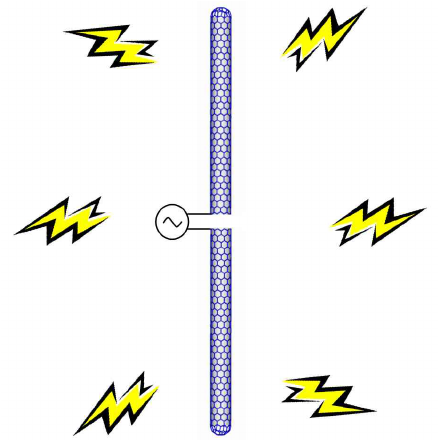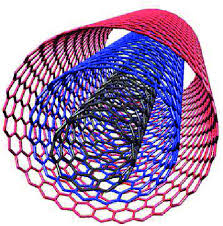Nano Telecommunications) Nanotube Antennas (CNTs) and Nano Tapes (GNRs) based on Nano-Microelectronics PhD
Researcher and author: PhD student Afshin Rashid
Note: Nano-telecommunications include electronic devices and devices , one of which is about one to a few hundred nanometers in size. On this basis, if we are to antennas used in parts of nanoparticles in the range should be expected electromagnetic waves used in communications systems and equipment around several tens of THz which in turn includes the wavelength region of infrared, visible and ultraviolet will be .
The antenna is the primary means of absorbing electromagnetic waves into space and has its own advanced engineering knowledge that is highly developed and extensive. Generally, to receive electromagnetic waves in space, the antenna dimensions must be in the order of magnitude of the input wavelength to its surface. Due to the very low dimensions of the nanosensors, the nanostructures need to be very high in order to be usable. The use of graphene greatly helps to solve this problem. Wave propagation speeds in CNTs and GNRs can be up to 100 times slower than vacuum, depending on the physical structure, temperature, and energy. Accordingly, the resonance frequency of graphene-based nano-antennas can be two times lower than that of nano-carbon-based nano-antennas.
One of the most important parameters of any nano antenna is the current distribution on it. This characteristic determines the radiation pattern, radiation resistance and reactance and many important properties of the antenna. With the possibility of fabricating nanomaterials with several centimeters of length, it is possible to fabricate electric conductors with a length-to-width ratio of 10 ^ 7 . At first glance, nanotube antennas give us the impression that it is similar to a small- scale dipole antenna . But it is not true in the original theory of dipole antennas to determine the distribution of current on the antenna, which has a dipole radius greater than the depth of the skin, and the resistive loss is so low that it is negligible. With regard to the nano dipole L / d is significantly smaller, non-significant is used. In single-dimensional electrical conductors such as nanotubes, the skin depth state is completely eliminated. Because here the electrons only allow movement They have conductors along the string, and so the current distribution is effectively one-dimensional. In addition to electrons moving in only one dimension, two other important problems occur, inductance and high resistance. These features create very different behavior for nanotube antennas than for classical antennas. The main difference is that the current distribution is intermittent with a wavelength that is 100 times smaller than the wavelength of free space for a given thermal frequency. The wavelength of the current distribution depends on the speed of the wave in that mode. If the wavelength is the speed of light, the wavelength of the current distribution is the wavelength of the electromagnetic waves in free space. On the other hand, the wave velocity in nanotubes is about one hundred times lower than the speed of light. This is because in circuit theory, the wave velocity is equal to the inverse of the second root of capacitance per unit length multiplied by the inductive capacity per unit length.
The kinetic inductance per nanotube length unit is ten thousand times greater than the magnetic induction per unit length. So the wave speed will be 100 times smaller than the speed of light. The efficiency of a classical nanotube antenna of -90dB is due to resistive losses. Antennas and nano-system or nano-sensor complexes, operating frequency, power losses, sensor network range and dimensions, power supply system and physical platform communication between different parts of a nano system, major factors and parameters Each of these is deterministic and determines the capability and performance of the final system.
Conclusion :
Graphene structures can be used to make nano- antennas, and this valuable structure can play a very important role. The manufacture of nano-antennas in different applications of telecommunication systems and communication with nanoscale systems is based on new fields and functions of nano-electronics telecommunication equipment and systems.
Author: Engineer Afshin Rashid
PhD student of Nano-Microelectronics at Islamic Azad University, Science and Research Branch, Tehran





